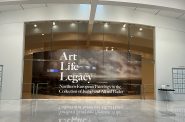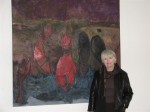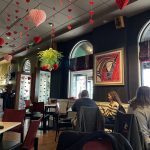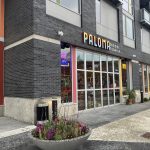Sixteen Blocks & What Have You Got?
It’s a mistake to assume that “temporary public art” projects are somehow superior (or inferior) to permanent works of public art. In:Site’s mission statement seems to suggest that temporary public art, organized and executed under their banner, is the way to go. The pitch is loosely built on this: if monies are to be spent on permanent art produced by artists not from Wisconsin, that’s not so good. The money, according to In:Site, should go to local artists who produce temporary art at a much lower cost. This spreads the loot around town, and that’s okay, but does it translate to art that is worth considering?
On Sunday, August 23, I walked most of the sixteen blocks, my second of three visits. The first foray began on Water Street in the area of #’s 16, 19, & 18, or so says the accurate map I picked up at the Park East Information Center and Museum in the Sydney Hih building. Artists and volunteers at the Hih are happy to give you an earful.
So there I was, trekking my way through a rubble-strewn field abloom with Queen Anne’s lace, chicory, golden rod, thistle and assorted other weeds, in search of #16, “Uniting the Fence.” Kasia Drake and a swarm of volunteers wove rags in and out of the sinuous links of chain that rim #16. Face it, chain link fencing is just plain unattractive, and no amount of righteous rags ripped and swagged prove otherwise. Perhaps the point was to get folks together in a moment of unification amidst acres of Ugly.
In the same area, #18 Annushka Peck’s “cede” pinned down both sides of Water Street: one version (orange) clung to the side of the massive white Laacke & Joys building; the other, a billboard-style map, was anchored in the soil directly across the busy thoroughfare. This is essentially a drive-by area. I noticed folks milling around, but most were headed to the Laacke & Joys tent sale. Peck’s work is strong, and it belongs near the top of the chosen eleven.
Chris Bach and Cat Pham had four installations, each titled “Framing Place,” and each more or less focused on the same concept, i.e., look through the openings in these painted (red) panels and see what you see. Two would have sufficed.

Chris Bach and Cat Pham’s “Framing” the east bank of the Milwaukee river as seen through vertical slats.
I was starting to feel that much of the effort was wasted. It’s a mistake to assume that “Gee Whiz, if the City of Milwaukee and the Milwaukee Arts Board gave it the green light, then it must be a good thing. Right?”
Liberace himself was a hoot, but the installation depicting the hometown boy tanks big time. The concept of Armando Gallegos, “Desire, Luxury, Showmanship,” is attached to the tip-top of the Time Warner Cable building at the corner of Knapp Street and MLK Jr. Drive, near “Water Source,” by Mary Osmundsen and Maria Bolivar (a mediocre piece attached on two sides of the exquisite gatehouse). The bridge is a beauty, so it was a mistake to use it as a platform for this particular installation. I learned quite by accident that Osmundsen and Bolivar had originally planned a statement about the privatization of our water, but the City of Milwaukee “edited” out what they didn’t like.
If this is true, it goes right along with my feeling that money handed out usually comes with strings attached. I take issue with the editing of all art, be it temporary or permanent. Rather reminds one of the Blue Shirt debacle.
But thank you, all ye Gods of Art, for the brains and brawn of Neil Gasparka (and Ruvin Development, Inc.) who put together a perfectly delightful “Park East Information Center and Museum” in the blasted skeleton of the building known fondly as Sydney Hih. It saved the entire project.
Don’t scurry through the premises. Take time to wend and wind and explore. Gasparka has a future in curating, and he’s off and running at 3rd and Juneau. I’d have to place the brilliant “Park East Corridor Property Company” first and foremost on my list. Packaged to real estate perfection by MIAD juniors Molly Noyes and Natalie LeRoy (with slick furnishings by Design Within Reach), it is one of the few installations that seems to understand concept. And it was fun. A friend of mine bid on a piece of property. Property in a box. Cool.
Hidden in the Information Center’s musty nooks and crannies are many such gems: the former site of Elements of Art & Design, the brainchild of entrepreneur Greg Dix. Within what’s left of the space, Dix developed architectural excellence in tandem with art and, fortunately, Gasparka chose to install the sculptural designs (lighting, chairs) of Christopher Poehlman, who still forges forth within the walls of The Nut Factory in Riverwest. Not only did Gasparka make fine choices about what went where, but he stripped and bashed his way through layers of walls (drywall, paneling circa late 60s, funky wallpaper, etc.), all in a quest to show us the way it was in the Way Back. I never knew Inova curator Nick Frank, who reputedly played a mean guitar, but there he is wearing what appears to be a sheet over his head, playing like mad in a murky video taped recently in the creepy bowels of Sydney Hih. This gem is only one of the delights at this site.
So why did (much) of the In:Site project falter? My head tells me it was too coy, too cute and, in some cases, very silly. That said, the installations that succeed are great and well worth the trip to the land of rubble.
I did have a lengthy chat with Pegi Taylor, and I offered a suggestion that future projects might benefit from the wisdom of mature mentors who understand site installations. Taylor, a dynamo by any measure, seems open to suggestions. You can contact her through In:Site’s website.
Art should inspire. On that Taylor and I agree. Unfortunately, this project made me perspire over sixteen blocks and a lot of effort, to no great effect.
Art
-
Exhibit Tells Story of Vietnam War Resistors in the Military
 Mar 29th, 2024 by Bill Christofferson
Mar 29th, 2024 by Bill Christofferson
-
See Art Museum’s New Exhibit, ‘Portrait of the Collector’
 Sep 28th, 2023 by Sophie Bolich
Sep 28th, 2023 by Sophie Bolich
-
100 Years Of Memorable Photography
 Sep 18th, 2023 by Rose Balistreri
Sep 18th, 2023 by Rose Balistreri






















“One could even say the corridor is an embarrassment to the city”
You would be really hard-pressed to say that. Milwaukee tore down a freeway stub, something that is studied and lauded in urban planning courses across the country. In the short-term it looks a little silly because with the county involved the land deal got rather botched, but that’s only the short-term.
I don’t think projects like the Aloft Hotel, North End, and Flatiron are embarrassments. Nor is the Kern Center or The Brewery.
Interesting review of a project that will unfortunately go unnoticed by too many that go right by it.
I snagged a bunch of photos myself and put them online.
http://urbanmilwaukee.com/2009/08/24/park-east-art-gallery/
-Jeramey Jannene-
thou protest too mightily Jeramey. The reference to embarrassment, is the fact that most of it remains empty. speaking of embarrassments (?), or maybe not, what’s up with the TransEra condo on Prospect?
Thank you Judith. Your piece serves to be one of the more objective takes on this installation. For at least a month I’ve read most of the reporting concerning the art focus here, and yet your piece seems to be the only critique I’ve come across. For how much press the project received, one would think there would be more commentary.
I find the project to be more of a marketing ploy than public art feature. I think the city ought to get most of the accolades here versus the artists for focusing our attention on such a fine jewel within our midst. Quite frankly, it’s a wasteland. I see this project as nothing short of an open house to lure developers to kick it’s tires and hopefully to get this land generating much needed tax revenue. Hopefully someone will come around and take the bite.
Since the art is temporary, I wonder if the materials used will recycled when the exhibit closes, or just thrown into a dumpster, or…
A final thought: Most of the site installations close this weekend, and before they do, you need to visit the Sydney Hih. In three visits, I overlooked two installations well worth mentioning: “Guide,” by Paul Druecke (posted on the south exterior of Hih), and a few doors south of that a wonderful installation addressing the alleged “squatters” who inhabited the building.Behind a unmarked blue door, you find a room with sleeping pallets (pale thin blankets, each with a pillow). It’s a mighty powerful statement about the use of the Park East Corridor…it’s too bad that more of the installations were not “allowed” to make socio-economic statements. Or so it seems.
apologies to my comment readers: the “squatters” installation is on the west end. Look for the screaming blue door.
one final word: I visited the closing of the In:Site project yesterday, a cool Sunday, and the biggest crowd ever gathered in the Hih. The talented ladies from MIAD have sold almost a dozen of their real estate property boxes. also had a chance to chat with artist Mutz who conceived the amazing squatters room, not behind the blue door as reported earlier, but behind the green door, but nevermind, as I write, we will have to wait for the next In:Site….